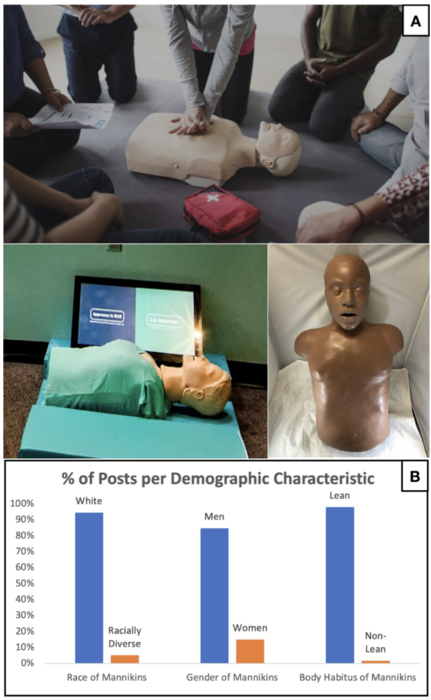Philadelphia, November 21, 2022 – Investigators found that there is a marked lack of diversity in the mannikins depicted by public social media accounts of organizations that administer cardiopulmonary (CPR) education. Less than 10% represented Black or Asian individuals and none represented pregnant women. Their study is published as a Research Letter in the Canadian Journal of Cardiology, an official journal of the Canadian Cardiovascular Society, published by Elsevier.

Credit: Canadian Journal of Cardiology
Philadelphia, November 21, 2022 – Investigators found that there is a marked lack of diversity in the mannikins depicted by public social media accounts of organizations that administer cardiopulmonary (CPR) education. Less than 10% represented Black or Asian individuals and none represented pregnant women. Their study is published as a Research Letter in the Canadian Journal of Cardiology, an official journal of the Canadian Cardiovascular Society, published by Elsevier.
Out-of-hospital cardiac arrest (OHCA) is a leading cause of morbidity and mortality worldwide, placing a psychological burden on survivors, families, friends, healthcare providers, and entire communities. In the United States, there are approximately 356,000 OHCAs annually. Nearly 90% of these arrests are fatal. In Canada alone, nearly 35,000 OHCAs occur annually, and fewer than 10% of patients survive to hospital discharge. Several factors impact the outcomes of OHCA, with the main contributing factor being effective CPR.
The DIVERSE I study (Determining the Importance of Various gEnders, Races and body Shapes for CPR Education) demonstrated that although CPR training is intended to simulate cardiac arrest, most manufactured models (mannikins) represent white lean men, who are only a small proportion of individuals who actually experience OHCA.
The primary aim of the DIVERSE II study (Determining the Importance of Various gEnders, Races and body Shapes for CPR Education: Images in MedIa), reported here, was to determine the diversity of mannikins represented on the public social media accounts of institutions, businesses, and non-governmental organizations that administer CPR certification.
“Diversity training is an important target for CPR education as it would theoretically change the perception of sudden cardiac death in a broad population,” explained lead investigator Adrian Baranchuk, MD, Department of Medicine, Kingston Health Sciences Center, Queen’s University, Kingston, ON, Canada. “Social media platforms are becoming cornerstones of medical education for students, physicians, and the public. It is crucial that these educational tools are representative of the populations receiving CPR, so we decided to investigate these platforms further.”
Researchers identified organizations from North America (NA) and South America (SA) through a collaboration with the Interamerican Society of Cardiology and compiled these into a comprehensive database. They analyzed social media posts from September 1, 2019, to September 19, 2021, using a nine-question data collection Google form to collect details including platform used (Twitter/Instagram), date of post, country, body shape, age, apparent race, and perceived gender. All mannikin characteristics were ascertained at the discretion of the authors, with any conflicts resolved by consensus.
In total, investigators collected 211 images of mannikins. From NA, 104 (49.3%) were identified and from SA, 107 (50.7%) were identified. Of these, only four (1.8%) used non-lean mannikins, 32 (15.2%) represented women, 14 (6.6%) represented children, eight (3.8%) represented black individuals, and three (1.4%) represented Asian individuals. None of the images represented pregnant women.
Overall, the researchers found there is a marked lack of diversity in the mannikins used by public social media accounts that advertise CPR education. “Awareness of this issue is crucial so that educational tools are representative of populations needing CPR in real life. Training should be different when treating patients such as infants or pregnant patients with varying CPR requirements,” noted Dr. Baranchuk.
“Future work should investigate solutions to minimize the implicit bias present in media posts of mannikins such as increasing the exposure to racially diverse mannikins with high frequencies to override preconceived notions. The link between improved mortality rates in diverse groups and an increase in bystander CPR rates with diverse individuals would be a future point of interest to study,” he concluded.
Recent North American estimates have shown that only 41% of OHCA patients receive bystander-initiated CPR, and fewer than 6% have an automated external defibrillator (AED) applied by a bystander before the arrival of professional responders, according to lead author Nicholas Grubic, MSc, Department of Medicine, Queen’s University, Kingston, ON, Canada, and coauthors in an accompanying editorial.
“The provision of care and survival after OHCA has been shown to differ by sociodemographic factors, most notably sex/gender and race,” they commented. “This study highlights a ‘real-world’ gap in sociodemographic diversity among health promotion media for OHCA. The paucity of mannikins representing non-lean, female or pregnant individuals identified by this analysis is concerning. This study provides important data to suggest that implicit biases in OHCA exist, and that these biases may influence disparities in OHCA training, care, and outcomes. Novel strategies that aim to alter historical perceptions of resuscitation and OHCA, which are rooted in cultural appropriation and lack of diversity, should be a public health priority.”
Journal
Canadian Journal of Cardiology
DOI
10.1016/j.cjca.2022.09.023
Method of Research
Observational study
Subject of Research
People
Article Title
Research Letter: Determining the Importance of Various GEnders, Races and Body Shapes for CPR Education Using Mannikins: Images in MedIa (DIVERSE II)
Article Publication Date
21-Nov-2022




